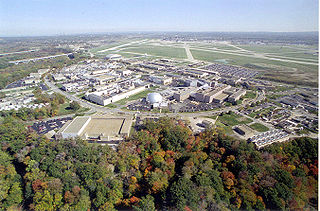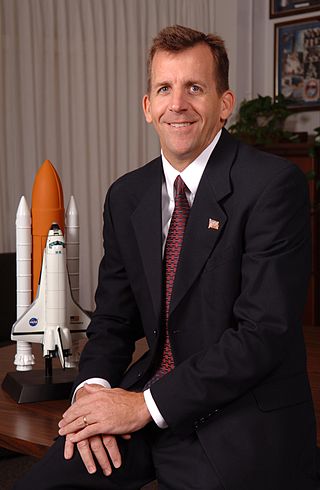
Jet Propulsion Laboratory (JPL) is a federally funded research and development center in La Cañada Flintridge, California, United States. Founded in 1936 by Caltech researchers, the laboratory is now owned and sponsored by the National Aeronautics and Space Administration (NASA) and administered and managed by the California Institute of Technology.

The Ames Research Center (ARC), also known as NASA Ames, is a major NASA research center at Moffett Federal Airfield in California's Silicon Valley. It was founded in 1939 as the second National Advisory Committee for Aeronautics (NACA) laboratory. That agency was dissolved and its assets and personnel transferred to the newly created National Aeronautics and Space Administration (NASA) on October 1, 1958. NASA Ames is named in honor of Joseph Sweetman Ames, a physicist and one of the founding members of NACA. At last estimate NASA Ames had over US$3 billion in capital equipment, 2,300 research personnel and a US$860 million annual budget.

The Goddard Space Flight Center (GSFC) is a major NASA space research laboratory located approximately 6.5 miles (10.5 km) northeast of Washington, D.C. in Greenbelt, Maryland, United States. Established on May 1, 1959 as NASA's first space flight center, GSFC employs about 10,000 civil servants and contractors. Named for American rocket propulsion pioneer Robert H. Goddard, it is one of ten major NASA field centers. GSFC is partially within the former Goddard census-designated place; it has a Greenbelt mailing address.

NASA John H. Glenn Research Center at Lewis Field is a NASA center within the cities of Brook Park and Cleveland between Cleveland Hopkins International Airport and the Rocky River Reservation of Cleveland Metroparks, with a subsidiary facility in Sandusky, Ohio. Its director is James A. Kenyon. Glenn Research Center is one of ten major NASA facilities, whose primary mission is to develop science and technology for use in aeronautics and space. As of May 2012, it employed about 1,650 civil servants and 1,850 support contractors on or near its site.

Harold (Hal) Masursky was an American astrogeologist.

LeRoy Edward Cain is an American aerospace engineer who worked for NASA as a flight director, launch integration manager and deputy manager of the Space Shuttle Program. Cain may be best known to the public from footage and documentaries showing his work as the entry flight director for STS-107, the mission that ended in the catastrophic disintegration of Space Shuttle Columbia, February 1, 2003. Cain issued the famous "Lock the doors" command, initiating contingency procedures in mission control for the first time since the Space Shuttle Challenger disaster 17 years earlier.

Arctic Slope Regional Corporation, or ASRC, is one of 13 Alaska Native Regional Corporations created under the Alaska Native Claims Settlement Act of 1971 (ANCSA) in settlement of aboriginal land claims. ASRC was incorporated in Alaska on June 22, 1972. Headquartered in Utqiaġvik, Alaska, with administrative offices in Anchorage, ASRC was as of 2017, a for-profit corporation with nearly 11,000 Alaska Native shareholders primarily of Inupiat Eskimo descent.

Olga D. González-Sanabria is a Puerto Rican scientist and inventor. She is the highest-ranking Hispanic at NASA Glenn Research Center, and a member of the Ohio Women's Hall of Fame. González-Sanabria, Director of the Engineering and Technical Services, is responsible for planning and directing a full range of integrated services including engineering, fabrication, testing, facility management and aircraft services for the Glenn Research Center. She played an instrumental role in the development of the "Long Cycle-Life Nickel-Hydrogen Batteries" which helps enable the International Space Station power system.

William H. Gerstenmaier is an aerospace engineer and policymaker who is Vice President, Build and Flight Reliability at SpaceX. He previously served as NASA's Associate Administrator for Human Exploration and Operations between 2005 and July 10, 2019. While in that role, he was described as "arguably the most influential person when it comes to US spaceflight." Prior to being Associate Administrator, Gerstenmaier served as the International Space Station Office Program Manager, at Johnson Space Center, a position he began in June 2002. He spent a total of four decades with NASA.

Goddard Space Flight Center is NASA's first, and oldest, space center. It is named after Robert H. Goddard, the father of modern rocketry. Throughout its history, the center has managed, developed, and operated many notable missions, including the Cosmic Background Explorer, the Hubble Space Telescope, the Tracking and Data Relay Satellite System (TDRSS), the Lunar Reconnaissance Orbiter, and the Solar Dynamics Observatory.

Swales Aerospace was an employee-owned, small business aerospace engineering firm. The company offered a full range of aerospace engineering services. It was the global leader in the development and manufacture of two-phase thermal solutions for spaceflight applications, and it was a small satellite mission provider. In 2007, it was acquired by Alliant Techsystems.
SpaceWorks Enterprises, Inc. (SEI) is an aerospace engineering company based in Atlanta, Georgia, United States that specializes in the design, assessment, hardware prototyping and flight demonstration of advanced space concepts for both government and commercial customers.

Robin Neely Henderson is the Associate Director, Management, of the NASA Marshall Space Flight Center located in Huntsville, Alabama. She was named to become the center's Acting Director effective August 3, 2012, following the retirement of the previous director, Arthur E. Goldman, to take a private sector position. On September 25, 2012, NASA named Patrick Scheuermann as the center's new permanent director.
Ashitey Trebi-Ollennu, is a Ghanaian robotics engineer at the National Aeronautics and Space Administration (NASA) and the chief engineer and technical group leader for the mobility and manipulation group at the Jet Propulsion Laboratory He has been associated with various NASA Mars missions, notably the Mars Rover and InSight projects.

Susan G. Finley, a native Californian, has been an employee of NASA's Jet Propulsion Laboratory (JPL) since January 1958, making her the longest-serving woman in NASA. Two days before Explorer 1 was launched, Finley began her career with the laboratory as a human computer, calculating rocket launch trajectories by hand. She now serves as a subsystem engineer for NASA's Deep Space Network (DSN). At JPL, she has participated in the exploration of the Moon, the Sun, all the planets, and other bodies in the Solar System.

David A. Spencer is the Mars Sample Return Campaign Mission Manager at the Jet Propulsion Laboratory. As an aerospace engineer, Spencer designs and operates planetary spacecraft.
Lew Allen Award for Excellence is a medal of the Jet Propulsion Laboratory. Established in 1986 as the Director’s Research Achievement Award; it was then renamed in honor of JPL's Director Lew Allen when he retired in 1990. This award recognizes significant accomplishments or leadership early in an individual's professional career at the Jet Propulsion Laboratory.
Jerry Chris Elliott High Eagle is a physicist and was one of the first Native Americans who worked at NASA. He is most known for his contributions as the lead retrofire officer during Apollo 13, where his actions saved the lives of the three astronauts on board. Elliott's work awarded him the Presidential Medal of Freedom, the highest civilian honor awarded by the President of the United States.

Carolyn Leach Huntoon is an American scientist and former government official. She was the director of the Johnson Space Center in Houston, Texas, a position which she held from 1994 to 1996, and was the first woman in the role. She was an assistant secretary at the Department of Energy from 1999 to 2001.














